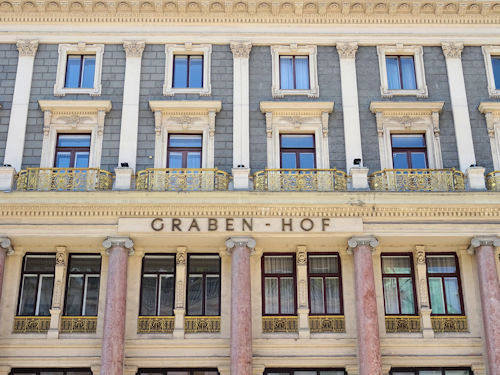
One of the more distinctive buildings at the heart of the pedestrianised center of Vienna is the Grabenhof.
- Late 19th-century design by Otto Wagner and Otto Thienemann
- Check the Ankerhaus next door, too
- Book a themed guided tour* of Vienna
- See also:
Grabenhof history

(Presumably a useful hint for food delivery services)
With its columns and decorated golden railings, the Grabenhof makes quite a sight among the historical buildings that surround it.
All the creativity seemingly went into the building’s architecture, though, rather than the name: Hof means court or courtyard and Graben is the name of the street outside.
You can spot it easily as you walk down the boulevard that connects Stephansdom cathedral with the Hofburg palace area, thanks to its location opposite the plague column. It also has the word “Grabenhof” written helpfully in large letters on its façade.
The first constructions on the site date back to at least the 14th century. Sometime in the late 16th century, the owners put up the Renaissance-style Arkadenhaus.

(The Grabenhof around 1880, shortly after its construction, as pictured by the Michael Frankenstein & Comp. photo studio; Wien Museum Inv.-Nr. 78079/51/2; excerpt reproduced with permission under the terms of the CC0 licence)
The Grabenhof, completed in 1876, then replaced the Arkadenhaus. In an unsurprising turn of events for Vienna, a coffee house soon moved in.
Otto Wagner and Otto Thienemann designed the building. I like to think they shared many amusing moments as a result of having the same first name. Though the joke may have worn off with time.
Even before the official completion of the project, the locals apparently gave their own name to the building: the Säulenhaus (house of columns) for reasons that become obvious when you see the photos.
Incidentally, another Wagner design stands just a few steps away: the Ankerhaus at Number 10. And you’ll find some nice examples of Jugendstil architecture in the same area.
For something a little further back in time, visit the baroque Peterskirche church on the other side of the road, perhaps for one of their lovely evening concerts by the Classic Ensemble Vienna.

(Look out for the decorated balcony railings)
As noted earlier, the Grabenhof site itself is replete with history.
The location apparently served as a bargaining chip for monasteries and dukes, provided holding cells for 16th-century courts, and housed the company that published Schubert’s music.
In 1804, they apparently announced Francis I’s new title of Emperor of Austria from one of the balconies.
This event is less impressive than it sounds, since Francis unilaterally declared himself Emperor of Austria, fearing (accurately as it turns out) that his existing title of Holy Roman Emperor would soon be made redundant by Napoleon’s European adventures.
Even the newer Grabenhof enjoyed its own brushes with history. It temporarily housed offices for the Nazis, for example. Rather more pleasantly, upmarket stores now fill the street-facing ground floor.
How to get to the Grabenhof
It’s hard to miss, being on one of the main tourist walking routes through the historic center of Vienna.
Subway: Wander up the Graben from the Stephansplatz station (on the U1 and U3 lines)
Bus: Lines 1A or 2A to Graben/Petersplatz
Address: Graben 14/15, 1010 Vienna